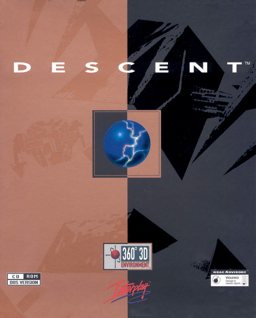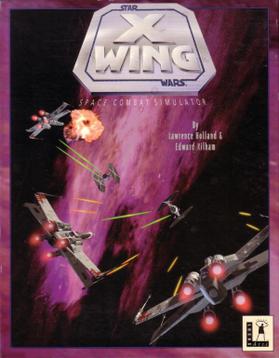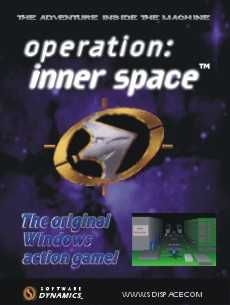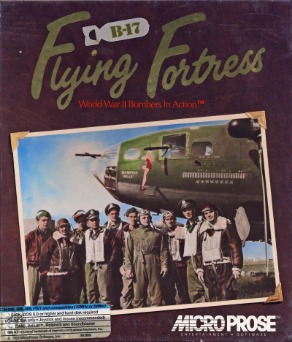
Rise of the Triad: Dark War is a first-person shooter video game, developed and published by Apogee Software in 1995. The player can choose to play as one of five different characters, each bearing unique attributes such as speed and endurance. The game's story follows these five characters who have been sent to investigate a deadly cult, and soon become aware of a deadly plot to destroy a nearby city. A remake was designed by Interceptor Entertainment and released by Apogee Games in 2013. The shareware version of the game is titled Rise of the Triad: The HUNT Begins.

A sound card is an internal expansion card that provides input and output of audio signals to and from a computer under the control of computer programs. The term sound card is also applied to external audio interfaces used for professional audio applications.

Descent is a first-person shooter (FPS) game developed by Parallax Software and released by Interplay Productions in 1995 for MS-DOS, and later for Macintosh, PlayStation, and RISC OS. It popularized a subgenre of FPS games employing six degrees of freedom and was the first FPS to feature entirely true-3D graphics. The player is cast as a mercenary hired to eliminate the threat of a mysterious extraterrestrial computer virus infecting off-world mining robots. In a series of mines throughout the Solar System, the protagonist pilots a spaceship and must locate and destroy the mine's power reactor and escape before being caught in the mine's self-destruction, defeating opposing robots along the way. Players can play online and compete in either deathmatches or cooperate to take on the robots.

The Gravis UltraSound or GUS is a sound card for the IBM PC compatible system platform, made by Canada-based Advanced Gravis Computer Technology Ltd. It was very popular in the demoscene during the 1990s.

Nitemare 3D is a horror-themed first-person shooter released by Gray Design Associates in 1994 for MS-DOS and Windows 3.x. There are three episodes with the first episode released as shareware and ten levels in each. The full release came on two 3½" floppy disks with a guide to the game's thirty levels. According to author David P. Gray, the game is the first pixelated Windows game to use the WinG interface. Along with WinDoom also from 1994, a similar first-person shooter, Bad Toys, was released for Windows 3.1 in 1995.

Tyrian is a vertically scrolling shooter developed by Eclipse Software for MS-DOS and published in 1995 by Epic MegaGames. Tyrian was programmed by Jason Emery, illustrated by Daniel Cook, and its music composed by Alexander Brandon and Andras Molnar. The game was re-released as freeware in 2004. A free and open-source port of the game started in April 2007.

The Adventures of Captain Comic is a platform game written by Michael Denio for MS-DOS compatible operating systems and released as shareware in 1988. It was one of the first side-scrolling games for IBM PC compatibles reminiscent of games for the Nintendo Entertainment System, and it presaged a trend of shareware platform games in the early 1990s. A version for the NES was later published by Color Dreams as an unlicensed title.

Star Wars: X-Wing is a space simulation video game, the first of the X-Wing combat flight simulation games series. The player's character flies starfighters, including the X-wing, for the Rebel Alliance. The narrative precedes and parallels the events of Star Wars Episode IV: A New Hope.

Terminal Velocity is a 1995 shooter video game originally developed by Terminal Reality and published by 3D Realms for DOS and Windows 95, and MacSoft for Mac OS. It is an arcade-style flight combat game, with simpler game controls and physics than flight simulators. It is known for its fast, high-energy action sequences, compared to flight simulators of the time.

Operation: Inner Space is an action game developed in 1992 and published in 1994 by Software Dynamics for Windows. The player's mission is to enter the computer in a spaceship and recover the icons and resources that have been set loose by an invasion, and ultimately to destroy the "Inner Demon". The player interacts with other spacecraft along the way, and can compete in races for icons.

Epic Pinball is a 1993 pinball video game developed by James Schmalz and published by Epic MegaGames. The initial release pre-dated Schmalz' Digital Extremes name. The game is played seen from a 2D top-down view within a scrollable window with plain raster graphics in 320x240. It was noted for being programmed entirely in x86 assembly language for MS-DOS systems.

B-17 Flying Fortress: World War II Bombers in Action is a combat flight simulation video game developed by Vektor Grafix and published by MicroProse for the PC MS-DOS in 1992 and for the Amiga and Atari ST in 1993. The game simulates training, combat missions and sorties in a tour of duty in the Eighth Air Force of the United States Army Air Forces in the European Theater of Operations aboard a Boeing B-17 Flying Fortress heavy bomber during World War II. It was followed by B-17 Flying Fortress: The Mighty 8th in 2000.

Major Stryker is a 2D vertically scrolling shooter video game written for DOS by Apogee Software. Its working title was "Strike Force" and was released in January 1993. It consists of three episodes, with the first episode distributed as shareware, and the rest available commercially. The three episodes are set on a Lava Planet, an Arctic Planet and a Desert Planet. The game was re-released as freeware on March 14, 2006, and on Steam with support for Microsoft Windows and macOS in 2014.

Nomad is a 1993 space trading and combat game developed by Intense! Interactive and Papyrus Design Group. It was published by GameTek for MS-DOS.

DemonStar is a video game developed by Mountain King Studios and published in 1998. Considered an unofficial sequel to the studio's earlier Raptor: Call of the Shadows, it is a top-down vertically scrolling shooter set in outer space.

Alpha Waves is a 1990 3D game that combines labyrinthine exploration with platform gameplay. It combined for the first time full-screen, six-axis, flat-shaded 3D with 3D object interaction. Alpha Waves was an abstract game with a moody, artistic presentation, named for its supposed ability to stimulate the different emotional centers of the brain with its use of color and music. The game was awarded the Guinness Book of Records title for First 3D platform game.

Star Wars: TIE Fighter is a 1994 Star Wars space flight simulator and space combat video game, a sequel in the Star Wars: X-Wing series. It places the player in the role of an Imperial starfighter pilot during events that occur between The Empire Strikes Back and Return of the Jedi.

Electro Man, originally distributed in Poland under the title Electro Body, is an MS-DOS platform game developed by the Polish company X LanD Computer Games. It was originally released in Poland by xLand in 1992, and later published by Epic MegaGames in the United States in 1993; apart from the changed title, the Electro Man release contains some changes, such as upgraded graphics. Though initially offered under a shareware license, the game was released as freeware by the developer on June 25, 2006, under the Creative Commons Attribution-ShareAlike 2.5 license. The player controls a cyborg named "Jacek", who must get through all the areas of a space base while destroying enemies.

Game-Maker is an MS-DOS-based suite of game design tools, accompanied by demonstration games, produced between 1991 and 1995 by the Amherst, New Hampshire based Recreational Software Designs and sold through direct mail in the US by KD Software. Game-Maker also was sold under various names by licensed distributors in the UK, Korea, and other territories including Captain GameMaker and Create Your Own Games With GameMaker!. Game-Maker is notable as one of the first complete game design packages for DOS-based PCs, for its fully mouse-driven graphical interface, and for its early support for VGA graphics, Sound Blaster sound, and full-screen four-way scrolling.



















